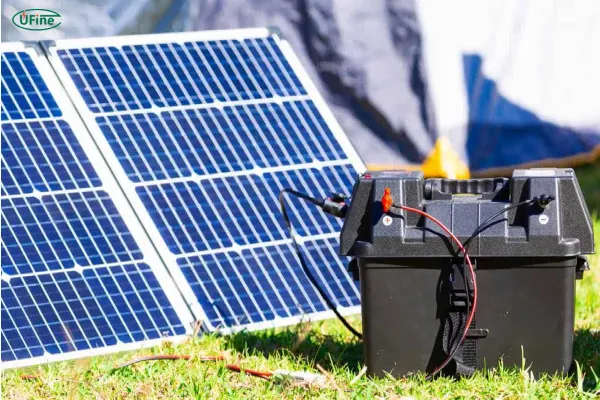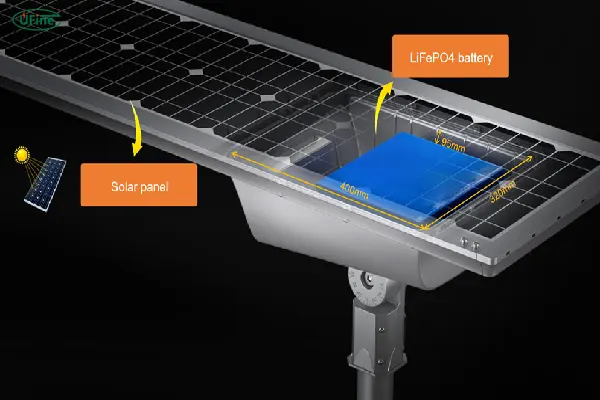Part 1. What is an LFP battery solar?
An LFP battery solar system refers to a solar energy storage solution that uses LiFePO4 (Lithium Iron Phosphate) batteries for storing the energy harvested by solar panels. LFP batteries are a type of lithium-ion battery but are preferred for solar energy storage due to their high efficiency, thermal stability, and long cycle life.
In these systems, solar panels generate electricity during the day, which is stored in the LFP battery for use when sunlight isn’t available, such as at night or on cloudy days. This makes LFP battery solar systems an ideal choice for homeowners, businesses, and remote areas looking to ensure a consistent and reliable power supply from renewable sources.
Part 2. Basic components and principles
An LFP battery solar system consists of several key components:
- Solar Panels: These convert sunlight into electricity, which is then sent to the battery for storage.
- Charge Controller: A charge controller is responsible for managing the energy flow between the solar panels and the battery, ensuring the battery is not overcharged or over-discharged.
- Inverter: The inverter converts the DC (direct current) energy stored in the battery to AC (alternating current) energy, which is used to power household appliances.
- LFP Battery Pack: The heart of the system, LiFePO4 batteries store the solar energy for later use.
The charge/discharge process in a solar LFP battery system is relatively straightforward. During daylight hours, solar panels generate power, and any surplus electricity is sent to the battery. At night, when the solar panels are not generating power, the battery discharges, providing energy to the load (household appliances, devices, etc.).
Part 3. How to charge and discharge solar LFP batteries?

Charging and discharging solar LFP (LiFePO4) batteries involves careful management of the voltage and current to maintain battery health and optimize performance over time. Here’s a detailed guide on how to properly charge and discharge your solar LFP battery.
Charging solar LFP batteries
Proper charging is crucial for the health and longevity of your solar LFP battery. The process should always follow these steps:
1. Using a Compatible Solar Charge Controller
Before starting the charging process, you must ensure you’re using a solar charge controller that’s designed for LiFePO4 batteries. These controllers manage the voltage and current coming from your solar panels to avoid overcharging, which can damage the battery.
- Solar Charge Controller: This component regulates the voltage sent to the battery from the solar panels, ensuring it’s within a safe range for LiFePO4 cells.
- MPPT (Maximum Power Point Tracking) Controllers are preferred for better efficiency, as they extract maximum power from the solar panels even under varying sunlight conditions.
2. Charging Voltage & Current
The charge parameters for LiFePO4 batteries vary slightly based on the system voltage (e.g., 12V, 24V, 48V) and battery capacity.
- Voltage Range: The typical charging voltage for LiFePO4 batteries is 3.6V – 3.65V per cell.
- For a 12V system, the charging voltage should be around 14.4V to 14.6V.
- For a 24V system, it’s around 28.8V to 29.2V.
- For a 48V system, the voltage should be 57.6V to 58.4V.
- Charging Current: The charging current should generally not exceed 0.5C to 1C. For instance, if your battery capacity is 100Ah, a safe charging current would range from 50A to 100A.
3. Charging Stages
Charging is typically divided into two main stages:
- Constant Current (CC) Stage: This stage happens when the battery is charged at a fixed current until it reaches its designated voltage limit.
- Constant Voltage (CV) Stage: Once the battery voltage reaches the limit, the charge controller maintains a constant voltage while the current gradually decreases. This prevents overcharging and minimizes stress on the battery.
4. Monitoring Charging
Using a Battery Management System (BMS) is highly recommended, as it helps ensure that no cell is overcharged or undercharged during the charging cycle. The BMS also protects the battery from temperature extremes and ensures that the cells are balanced.
Discharging solar LFP batteries
Discharging the solar LFP battery is the process of using the energy stored within the battery to power your home or other systems. Here are the steps to properly discharge a solar LFP battery:
1. Understand the Depth of Discharge (DoD)
LiFePO4 batteries can handle a high depth of discharge (DoD) without significant degradation, typically up to 80% to 90% DoD. This means you can safely use up most of the stored energy, but it’s best to avoid discharging below 20% (or 10.5V for a 12V system) to preserve the health of the battery.
2. Set Discharge Cutoff Limits
A low-voltage cutoff is essential to protect your solar LFP battery from being over-discharged. If the voltage drops below a certain point (usually 11.5V for 12V systems), the Battery Management System (BMS) should disconnect the load to prevent damage.
- For a 12V system, the cutoff is typically set around 10.5V to 11V.
- For 24V and 48V systems, the cutoff voltage should be adjusted proportionally based on the battery configuration.
3. Use a Proper Inverter for DC to AC Conversion
If you are powering AC appliances, you’ll need a DC-to-AC inverter that is compatible with the battery voltage. For example, a 12V LFP battery would require a 12V inverter.
- Ensure the inverter’s power rating matches the peak load your system will experience. Solar inverters typically come with built-in protections to prevent the battery from discharging too rapidly or too low.
4. Discharge Rate
It’s important not to discharge the battery too quickly. The discharge rate should generally follow 0.5C to 1C (capacity in Ah). For instance, a 200Ah LFP battery should ideally not discharge faster than 100A.
- Fast discharges can cause the battery to heat up, reducing overall efficiency and lifespan.
- Gradual discharge ensures that the system operates optimally and lasts longer.
5. Monitor Battery State
Just as you monitor the charging process, you should also monitor discharge behavior. Many solar inverters and charge controllers offer real-time data on battery voltage, charge level, and health.
Part 4. Pros and cons of solar LFP batteries
Pros:
- Long Cycle Life: LFP batteries typically have a cycle life of 3,000–5,000 cycles, which is significantly higher than other lithium-ion chemistries. This means solar LFP batteries can last for 10–15 years or more with proper maintenance.
- Safety: Unlike other lithium-ion chemistries, LiFePO4 batteries are thermally stable, making them less prone to thermal runaway or fires, even under extreme conditions.
- Efficiency: LFP batteries have high charge/discharge efficiency (up to 98%), ensuring that minimal energy loss occurs during storage and retrieval.
- Environmental Friendliness: The raw materials used in LFP batteries, including iron and phosphate, are abundant and non-toxic, making them more environmentally friendly than other lithium-based batteries.
- High Depth of Discharge (DoD): LFP batteries support a high depth of discharge (up to 80%–90%) without damaging the battery, meaning they can store and release more energy than other types of batteries.
Cons:
- Energy Density: While LiFePO4 batteries have excellent performance and safety, they are not as energy-dense as other lithium-ion chemistries such as NCM (Nickel-Cobalt-Manganese), meaning they require larger physical space to store the same amount of energy.
- Cost: LFP batteries tend to be more expensive than traditional lead-acid batteries, though they are more cost-effective over the long term due to their longer lifespan and higher efficiency.
Part 5. How long does a solar LFP battery last?
The lifespan of a solar LFP battery depends on a variety of factors, including usage, maintenance, and environmental conditions. On average, LiFePO4 batteries can last 10–15 years, and in some cases, even longer with proper care.
Here are a few considerations that affect the lifespan of solar LFP batteries:
- Cycle Life: LFP batteries typically offer 3,000 to 5,000 charge-discharge cycles, depending on how deeply the battery is discharged and how often it’s used. This makes them an excellent choice for solar systems where batteries undergo frequent cycling.
- Temperature: The performance of LFP batteries is best when kept within an optimal temperature range (around 25°C / 77°F). Extreme temperatures (either very high or very low) can reduce the battery’s overall lifespan.
Part 6. Maintenance and care for solar LFP batteries
Proper maintenance is crucial to extending the life of a solar LFP battery system. Below are some important maintenance tips:
- Regular Monitoring: Regularly check the voltage and charge levels of the battery to ensure that it is not overcharged or undercharged.
- Clean the Solar Panels: Keep your solar panels clean to ensure that they are functioning at their peak efficiency. Dirty panels can reduce the amount of energy being generated.
- Temperature Control: Ensure that the battery is stored in a cool, dry place, avoiding extreme heat or cold that could shorten the battery’s life.
Part 7. Choosing the best solar LFP battery: key parameters to consider
When purchasing a solar LFP battery, several key parameters should be taken into account:
- Capacity (Ah): The capacity of a battery, typically measured in ampere-hours (Ah), indicates how much energy the battery can store. Larger batteries can store more energy, but they are also larger and more expensive.
- Voltage (V): Ensure that the battery voltage matches your solar system’s voltage. Most solar LFP batteries come in 12V, 24V, or 48V configurations, so choose the one that fits your setup.
- Depth of Discharge (DoD): Look for a battery with a high DoD (80% or higher) to maximize the usable energy and lifespan of the battery.
- Cycle Life: Choose a battery with a high cycle life (over 3,000 cycles) for long-term savings.
- Warranty: Check the manufacturer’s warranty, which can indicate the reliability and longevity of the battery. Many solar LFP batteries offer warranties ranging from 5 to 10 years.
If you’re interested in purchasing or learning more about our solar LFP battery packs, contact us today to discuss how we can help power your renewable energy projects efficiently and sustainably.
Related Tags:
More Articles

LFP Batteries vs. Other: Which One Lasts Longer for Scooters?
Discover how LFP batteries compare to others for scooters. Learn which option offers better performance and safety. Choose wisely; read now!
Lithium Iron Phosphate vs Lithium Phosphate: What’s the Difference?
Lithium iron phosphate (LiFePO4) and lithium phosphate batteries are often confused. This article highlights their differences in efficiency, safety, lifespan.
What Size Rechargeable Batteries Do Small Flashlights Use?
This helpful guide explains the different rechargeable battery sizes for small flashlights and helps you choose the best one for your needs.
How to Improve Battery Performance Using a Voltage Regulator Lithium?
Learn how lithium voltage regulators improve battery performance, extend lifespan, and optimize efficiency in devices and systems.
What Is an Oxide Battery and How Does It Differ from Other Types of Batteries?
Oxide batteries are a unique technology with potential for various uses. Learn about their functions, advantages, and how they differ from other types.




